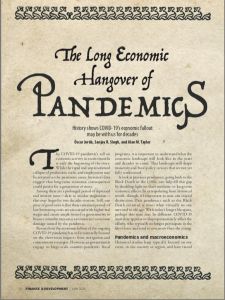Join getAbstract to access the summary!

Join getAbstract to access the summary!
Òscar Jordà, Sanjay R. Singh and Alan M. Taylor
The Long Economic Hangover of Pandemics
History shows COVID-19’s economic fallout may be with us for decades
IMF, 2020
What's inside?
The economic aftermath of the coronavirus could be long and arduous.
Recommendation
While the global economy will revert to some sort of normal as the effects of COVID-19 recede, the damage done will nonetheless cast a pall for years to come. In this sobering article, economists Òscar Jordà, Sanjay R. Singh and Alan M. Taylor look back at nearly seven hundred years of pandemics in Europe and find that the crises’ financial effects persisted long after their health impacts subsided. While current demographic and medical circumstances differ from those in the past, the economic aftermath of COVID-19 may well be long and arduous.
Take-Aways
- COVID-19 will reshape the macroeconomic landscape for decades.
- Pandemics exert a lasting influence on interest rates.
- Circumstances today could mitigate a long-term decline in the natural rate of interest.
Summary
COVID-19 will reshape the macroeconomic landscape for decades.
While the near-term effects of the coronavirus on trade, labor markets and output may recede to some degree as the public health threat diminishes, the pandemic’s longer term consequences will likely reverberate for many years.
““The COVID-19 pandemic’s toll on economic activity in recent months is only the beginning of the story.” ”
Economic growth could languish, and interest rates could reach new depths. Aggravating the problem is the high degree to which economies and markets are now integrated around the world.
Pandemics exert a profound influence on interest rates.
The natural rate of interest marks the point at which an economy can grow and at the same time keep inflation in check. Low levels of the rate correspond to an overall propensity to save rather than to invest, leading to sluggish economic growth. Analyses of data on 15 major pandemics in Europe – from the Black Death in 1331 through to H1N1 in 2009 – show that, following a health crisis, the natural rate of interest decreases steadily to reach a level after 20 years that is nearly 1.5 percentage points lower. Pandemics also result in reduced labor-to-capital ratios, as fatal diseases cut population numbers but do not destroy assets.
““For perspective, that [1.5-percentage-point] decline is comparable to what we have experienced from the mid-1980s to today.””
Research indicates that another two decades have to elapse before the natural rate of interest crawls back to where it was before the pandemic.
Circumstances today could mitigate a long-term decline in the natural rate of interest.
Secular stagnation – in which long-term low interest rates tamp down economic development – could continue for years. But three present-day factors might moderate the drop in real interest rates in the coronavirus’s wake: First, modern medicine and hygiene practices could lessen this pandemic’s fatality rate.
““On net, we still expect a sustained period of low real interest rates.” ”
Second, during previous pandemics, life expectancy was shorter than it is today. COVID-19 is claiming a disproportionate number of victims among the elderly, who tend to save more and are not in the active workforce. Third, massive fiscal spending to reboot economic activity – at favorably low borrowing costs – will generate sizable public debt, which in turn would decrease the savings rate and perhaps push real interest rates up.
About the Authors
Òscar Jordà, a senior policy adviser at the Federal Reserve Bank of San Francisco, is an economics professor at the University of California, Davis, where Sanjay R. Singh is an assistant professor of economics and Alan M. Taylor is a professor of economics and finance.
This document is restricted to personal use only.




















Comment on this summary